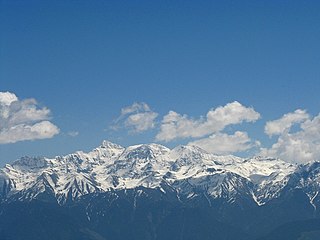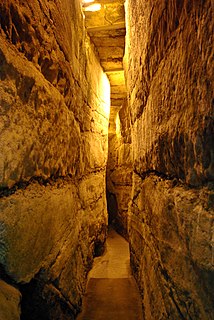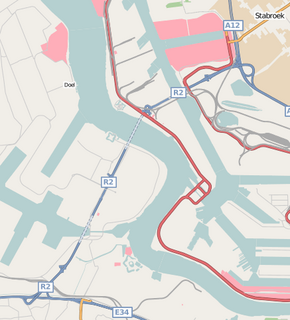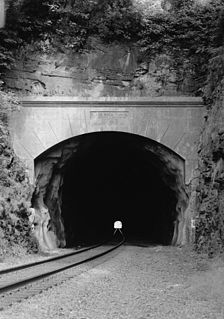The Gousselerbierg Tunnel is a pair of parallel road tunnels in the canton of Mersch, in central Luxembourg. The tunnels are named for the hill through which they pass, near the town of Gosseldange, in the commune of Lintgen. At 2,695 metres (8,842 ft), the Gousselerbierg Tunnel is the second-longest tunnel in the country, after the Grouft Tunnel, at 2,950 metres (9,678 ft). [1]
The tunnel carries the A7 motorway, and is the first of three major tunnels on the route of the road, together with the Grouft Tunnel and the Stafelter Tunnel (1,850 m). [2] Each of the twin tunnels contains two lanes of traffic in one direction. At its maximum, the tunnel lies 115 metres (377 ft) below the surface of the hill. [2]
The tunnel was constructed using the New Austrian Tunnelling method, relying on the stress of the surrounding rock to stabilise the tunnel. [2] Preparatory work on the tunnel began on 17 April 2000, and drilling work began on 21 November of the same year. The breakthrough ceremony was held on 12 December 2002, with Grand Duke Henri detonating the explosive charge that connected the two ends of the tunnels. [2] Altogether, the tunnel cost €100m to construct, and 420,000 m³ (14.8m cu ft) of earth were excavated, 65% of which was removed by explosives. [2]

The Blackwall Tunnel is a pair of road tunnels underneath the River Thames in east London, England linking the London Borough of Tower Hamlets with the Royal Borough of Greenwich, and part of the A102 road. The northern portal lies just south of the East India Dock Road (A13) in Blackwall; the southern entrances are just south of The O2 on the Greenwich Peninsula. The road is managed by Transport for London (TfL).

Hegra Fortress is a small mountain fortress in the village of Hegra in the municipality of Stjørdal in Trøndelag county, Norway. Originally known as Ingstadkleiven Fort, it was built between 1908–1910 as a border fort as a defence against the perceived threat of a Swedish invasion.

Gore Hill is an urban locality on the Lower North Shore of Sydney, New South Wales, Australia. Gore Hill locality located in the western part of the suburb of Artarmon, and the north west of the suburb of St Leonards.

The Pir Panjal Range, also Panchaladeva in Hindu scriptures, is a group of mountains in the Inner Himalayan region, running from east-southeast (ESE) to west-northwest (WNW) across the Indian state of Himachal Pradesh and Indian Union Territory of Jammu and Kashmir and the Pakistani territory of Jammu and Kashmir where the average elevation varies from 1,400 m (4,600 ft) to 4,100 m (13,500 ft). The Himalayas show a gradual elevation towards the Dhauladhar and Pir Panjal ranges. Pir Panjal is the largest range of the Lesser Himalayas. Near the bank of the Sutlej river, it dissociates itself from the Himalayas and forms a divide between the rivers Beas and Ravi (union territor on one side and the Chenab on the other. The renowned Galyat mountains are also located in this range.

European route E69 is an E-road between Olderfjord and North Cape in northern Norway. The road is 129 km (80 mi) long. It contains five tunnels, totalling 15.5 km (9.6 mi). The longest, the North Cape Tunnel, is 6.9 km (4.3 mi) long and reaches 212 m (696 ft) below sea level.

The Kalka–Shimla railway is a 2 ft 6 in narrow-gauge railway in North India which traverses a mostly-mountainous route from Kalka to Shimla. It is known for dramatic views of the hills and surrounding villages. The railway was built under the direction of Herbert Septimus Harington between 1898 and 1903 to connect Shimla, the summer capital of India during the British Raj, with the rest of the Indian rail system.

Gosseldange is a small town in the commune of Lintgen, in central Luxembourg. As of 2001, the town has a population of 442.

Banihal is a town and a notified area committee in Ramban district in the Indian Union territory of Jammu and Kashmir. It is a rural and a hilly area with Kamirwah being one of the most spectacular hills. It is located about 35 km (22 mi) away from Qazigund of Anantnag district on NH 44. However, the distance between Banihal and Qazigund is only 18 km by train on the new railway line which is much shorter than the road. The most common language spoken in the region is Kashmiri; Urdu Gujjari English being other familiar languages.

The Brenner Base Tunnel is an under-construction 55-kilometre-long (34 mi) railway tunnel through the base of the Eastern Alps beneath the Brenner Pass. It will run from near Innsbruck, in Austria, to Fortezza, in Italy, replacing part of the current Brenner railway. The line is part of Line 1, the Berlin to Palermo route, of Trans-European Transport Networks (TEN-T).

The Western Wall Tunnel is a tunnel exposing the Western Wall from where the traditional, open-air prayer site ends and up to the Wall's northern end. Most of the tunnel is in continuation of the open-air Western Wall and is located under buildings of the Muslim Quarter of the Old City of Jerusalem. While the open-air portion of the Western Wall is approximately 60 metres (200 ft) long, the majority of its original length of 488 metres (1,601 ft) is hidden underground. The tunnel allows access to the remainder of the Wall in a northerly direction.

The A4232, which is also known either as the Peripheral Distributor Road (PDR) or the Cardiff Link Road, is a distributor road in Cardiff, the capital of Wales.

The René Konen Tunnel, colloquially known as the Saint Esprit Tunnel, is a 655 m (2,149 ft) road tunnel in Luxembourg City in southern Luxembourg. It carries two lanes of one-way traffic northwards, under Ville Haute, bypassing the narrow streets and pedestrian zone in the heart of the city.

The Palani Hills Wildlife Sanctuary and National Park is a proposed protected area in Dindigul District, Tamil Nadu India. The park will be an upgrade and expansion of the 736.87 km2(PRO) Palani (Kodaikanal) Wildlife Sanctuary which was to be established in 2008. The park includes about 36% of the 2,068 square kilometres (798 sq mi) in the Palani Hills. The park is located between latitude 10°7' - 10°28' N and longitude 77°16' - 77°46' E. Central location is 1.5 kilometres (0.93 mi) east northeast of Silver Cascade Waterfall and 4 kilometres (2.5 mi) E X NE of Kodaikanal Lake.

The Hindhead Tunnel, opened in 2011, is part of the 6.5 km dual-carriageway Hindhead bypass that replaced one of the last remaining stretches of single-carriageway on the 68-mile (109 km) A3, the London to Portsmouth road. The bypass was constructed to improve road safety, reduce congestion and improve air quality. At 1,830 metres in length, the tunnel is the longest non-estuarial road tunnel in the United Kingdom, and takes the road beneath the Devil's Punch Bowl, a Site of Special Scientific Interest.

The Liefkenshoektunnel is a toll tunnel between Antwerp and Beveren under the River Schelde. The tunnel is a continuation of Highway R2, the ring motorway surrounding the city and harbour of Antwerp. In 2010 the tunnel was used by 6,373,894 vehicles. Positioned between the Beverentunnel and the Tijsmanstunnel, the Liefkenshoektunnel is the second of three sequential road tunnels running under the river and port installations.
Cuca is a commune in Argeș County, in southern central Romania. It is composed of fourteen villages: Bălțata, Bărbălani, Cârcești, Cotu, Crivățu, Cuca, Lăunele de Sus, Măcăi, Mănești, Sinești, Stănicei, Teodorești, Valea Cucii and Vonigeasa. It was one of the most remote places in Romania. Today, in Romanian language, Cuca Măcăii means "a remote village or place, very difficult to reach".

Atal Tunnel, named after India's Former Prime Minister Atal Bihari Vajpayee, is a highway tunnel being built under the Rohtang Pass in the eastern Pir Panjal range of the Himalayas on the Leh-Manali Highway. At 8.8 km (5.5 mi) length, the tunnel will be one of the longest road tunnels in India and is expected to reduce the distance between Manali and Keylong by about 46 km (28.6 mi). The tunnel is at an elevation of 3,100 metres (10,171 ft) whereas the Rohtang Pass is at an elevation of 3,978 metres (13,051 ft). The excavation of the tunnel completed in October 2017 when the blasting from south and north ends joined, and the completed tunnel will open in June 2020.

The Black Rock Tunnel is an active rail road tunnel of the old Reading Railroad. The 1835 tunnel was the third rail tunnel constructed in the United States, and is the third oldest still in use. The tunnel is also notable as being the first for which shafts were sunk during construction. The tunnel is cut through a hill in Phoenixville, Pennsylvania, United States. The tunnel and line are now owned by Norfolk Southern as part of its Harrisburg Line.

The Pir Panjal Railway Tunnel or Banihal railway tunnel is an 11.215 km railway tunnel located in Pir Panjal Range of middle Himalayas in Jammu and Kashmir, India, north of Banihal town. It is a part of the Jammu–Baramulla line.

At the start of the Battle of Messines (7–14 June 1917) during the First World War, a series of underground explosive charges were detonated by the British Army beneath German lines near the village of Mesen, in Belgian West Flanders. The mines, secretly planted by British tunnelling units, created 19 large craters and are estimated to have killed approximately 10,000 German soldiers. Their joint explosion ranks among the largest non-nuclear explosions of all time.


















